Pesticide Usage in Scotland: Outdoor Vegetable Crops 2017
This publication presents information from a survey of pesticide use on outdoor vegetable crops grown in Scotland during 2017.
2017 Pesticide usage
Vining peas
- An estimated 7,808 hectares of vining peas were gown in Scotland in 2017, an increase of 11 per cent since 2015
- 100 per cent of the crop was treated with a pesticide (see Figure 9 for types of pesticides used)
- Pesticide formulations were applied to 31,571 treated hectares with 18,719 kilograms of pesticide applied in total (see summary table below)
- Vining pea crops received on average 2.3 pesticide applications ( Table 1). These included 1.4 herbicide applications (applied to 96 per cent of the crop area), 1.1 insecticide applications (applied to 75 per cent of the crop) and one fungicide and one sulphur application (applied to 70 and 18 per cent of the crop respectively)
- Timings of pesticide applications are shown in Figure 10
- The only reasons specified for fungicide and herbicide use were disease control and general weed control. There were no reasons recorded for insecticide or sulphur use
- The most common varieties encountered were Spandimo, Corus and Pizarro, accounting for 21, 17 and 10 per cent of the sample area respectively
Summary of pesticide use on vining peas:
| Pesticide group |
Formulation area treated |
Weight of pesticides applied |
Percentage of crop treated |
Most used formulations |
|---|---|---|---|---|
| ha |
kg |
% |
ha |
|
| Fungicides |
5,597 |
1,428 |
70 |
Azoxystrobin (2,764), Boscalid/pyraclostrobin (2,687) |
| Herbicides |
10,452 |
10,062 |
96 |
Imazamox/pendimethalin (6,114) |
| Insecticides |
6,284 |
740 |
75 |
Pirimicarb (5,516) |
| Sulphur |
1,432 |
5,727 |
18 |
N/A |
| Seed treatments |
7,807 |
762 |
100 |
Cymoxanil/fludioxonil/ metalaxyl-M (7,807) |
| All pesticides |
31,571 |
18,719 |
100 |
N/A = not applicable
Figure 9 Use of pesticides on vining peas (percentage of total area treated with formulations) – 2017
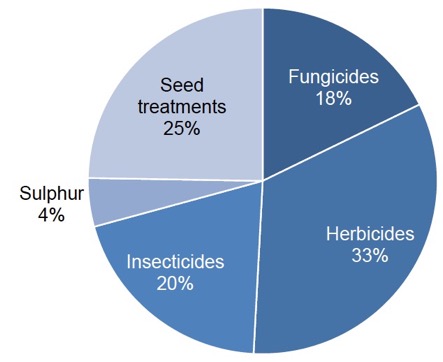
Figure 10 Timing of pesticide applications on vining peas – 2017
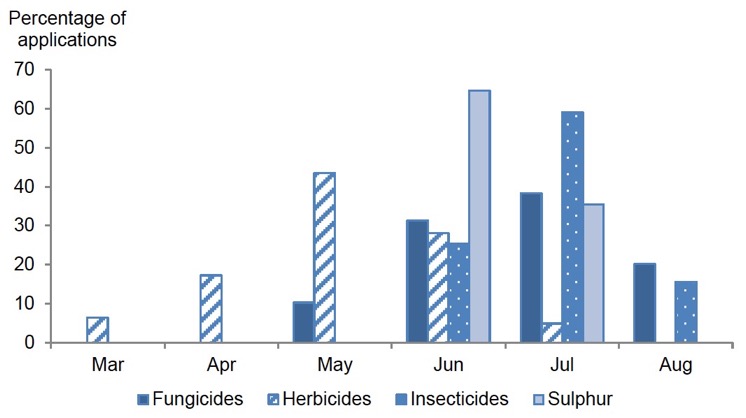
Broad beans
- An estimated 1,779 hectares of broad beans was grown in Scotland in 2017, an increase of 21 per cent since 2015. This was comprised of 1,767 hectares recorded in the ‘broad bean’ census category and 12 hectares recorded in the ‘other vegetable’ census category
- 99 per cent of the crop was treated with a pesticide (see Figure 11 for types of pesticides used)
- Pesticide formulations were applied to 14,707 treated hectares with 5,440 kilograms of pesticide applied in total (see summary table below)
- The 99 per cent of broad bean crop treated with a pesticide received on average 4.3 pesticide sprays ( Table 1). These included 2.7 fungicide applications, 2.1 insecticide applications and 1.4 herbicide applications (applied to 99, 90 and 90 per cent of the crop respectively)
- Timings of pesticide applications are shown in Figure 12
- Reasons for fungicide applications were supplied for 19 per cent of total use; 7 per cent for control of chocolate spot and 12 per cent for general disease control. The only reason specified for herbicides was general weed control (50 per cent use) and for insecticides was aphid control (16 per cent of use)
- The two main varieties encountered were Listra and Talia, accounting for 75 and 17 per cent of the sampled area respectively
Summary of pesticide use on broad beans:
| Pesticide group |
Formulation area treated |
Weight of pesticides applied |
Percentage of crop treated |
Most used formulations |
| ha |
kg |
% |
ha |
|
| Fungicides |
7,323 |
2,895 |
99 |
Tebuconazole (2,007) |
| Herbicides |
2,299 |
2,164 |
90 |
Imazamox/pendimethalin (1,601) |
| Insecticides |
3,318 |
87 |
90 |
Lambda-cyhalothrin (2,171) |
| Seed treatments |
1,767 |
294 |
99 |
Thiram (1,767) |
| All pesticides |
14,707 |
5,440 |
99 |
Figure 11 Use of pesticides on broad beans (percentage of total area treated with formulations) - 2017
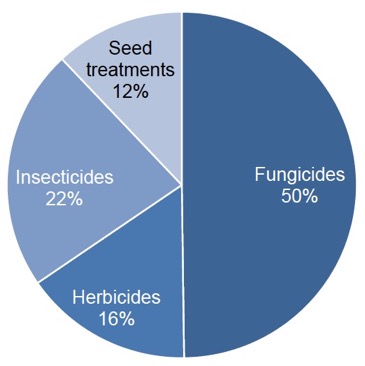
Figure 12 Timing of pesticide applications on broad beans – 2017
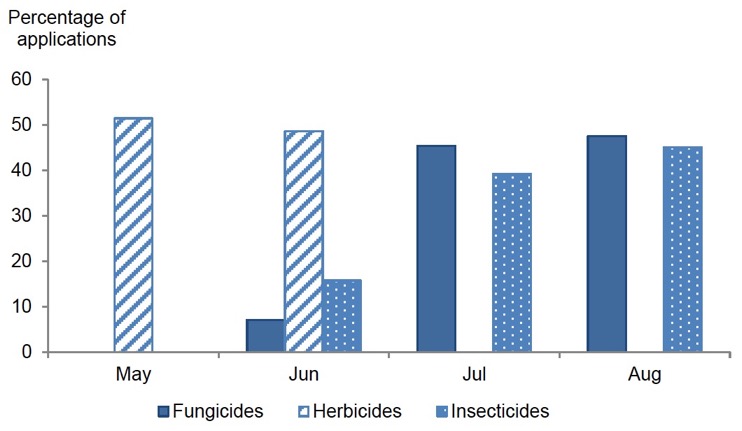
Cabbages
- An estimated area of 313 hectares was grown in Scotland in 2017. This represents an increase of 5 per cent since 2015. 278 hectares were recorded in the ‘cabbage and savoy’ census category and 35 hectares in the ‘other vegetable’ category
- 96 per cent of the cabbage crop was grown from transplants
- 89 per cent of the crop was treated with a pesticide (see Figure 13 for types of pesticides used)
- Pesticide formulations were applied to 2,314 treated hectares with 1,511 kilograms of pesticide applied in total (see summary table below)
- The 89 per cent of cabbage crop treated with a pesticide received on average 5.9 pesticide applications (Table 1). These included 3.3 fungicide applications, 1.9 herbicide applications and one molluscicide application (applied to 81, 89 and 81 per cent of the crop respectively)
- Timings of pesticide applications are shown in Figure 14
- The only reason specified for herbicide use was general weed control (eight per cent of use). No reasons were recorded for fungicide use
- The most common varieties encountered were Dutchman, Monarchy and Regency which accounted for 32, 28 and 24 per cent of the sample area respectively
Summary of pesticide use on cabbages:
| Pesticide group |
Formulation area treated |
Weight of pesticides applied |
Percentage of crop treated |
Most used formulations |
| ha |
kg |
% |
ha |
|
| Fungicides |
1,020 |
415 |
81 |
Azoxystrobin (508) |
| Herbicides |
1,040 |
1,025 |
89 |
Metazachlor (278), Clomazone, Glyphosate, Pendimethalin (all 254) |
| Molluscicides |
254 |
71 |
81 |
Metaldehyde (254) |
| All pesticides |
2,314 |
1,511 |
89 |
Figure 13 Use of pesticides on cabbages (percentage of total area treated with formulations) – 2017
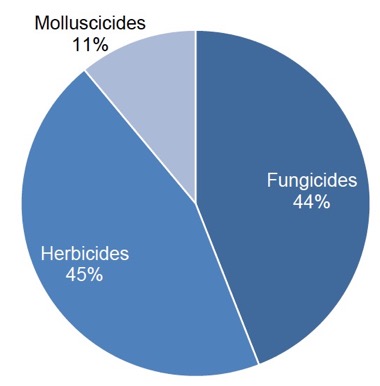
Figure 14 Timing of pesticide applications on cabbages – 2017
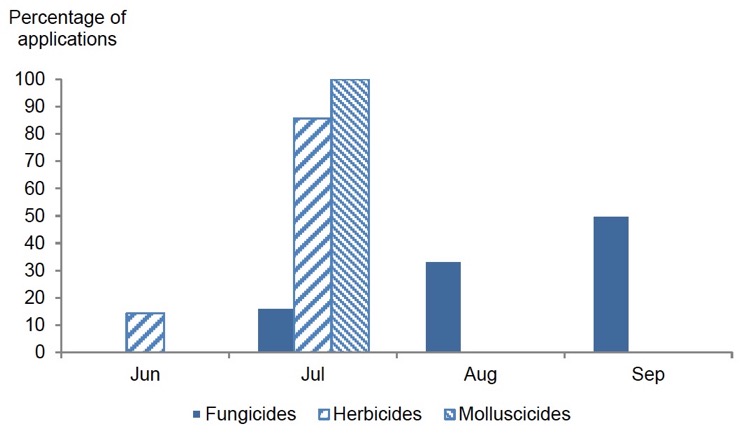
Calabrese
- An estimated area of 1,995 hectares of calabrese was grown in Scotland in 2017, an increase of 18 per cent since 2015. This included 1,718 hectares recorded in the ‘calabrese’ census category with the remainder recorded in the ‘other vegetable' category
- Over 99 per cent of the calabrese crop was grown from transplants
- 94 per cent of the crop was treated with a pesticide (see Figure 15 for types of pesticides used)
- Pesticide formulations were applied to 15,481 treated hectares with 7,520 kilograms of pesticide applied in total (see summary table below)
- The 94 per cent of calabrese crop treated with a pesticide received on average six pesticide applications ( Table 1). These applications included three molluscicides (applied to 12 per cent of the crop area), 2.6 fungicides, two herbicides,1.7 insecticides (applied to 92 per cent of the crop) and one sulphur application (applied to 41 per cent of the crop)
- The timings of pesticide applications are shown in in Figure 16
- 65 per cent of fungicide use was for downy mildew, 27 per cent for botrytis and eight per cent for head rot. General weed control was the only specified reason for herbicide use (73 per cent of use). Reasons for insecticide applications were supplied for 56 per cent of total use. 19 per cent was for caterpillars, 14 per cent for general pests, 10 per cent for both diamond-back moth and hoverfly and two per cent for pollen beetle. Please note hoverflies are classified as beneficial insects, but may be treated to reduce the presence of hoverfly larvae in the harvested crop
- The most common varieties encountered were Parthenon accounting for 51 per cent of the sample area and Monrello and Titanium both 18 per cent
Summary of pesticide use on calabrese:
| Pesticide group |
Formulation area treated |
Weight of pesticides applied |
Percentage of crop treated |
Most used formulations |
|---|---|---|---|---|
| ha |
kg |
% |
ha |
|
| Fungicides |
5,526 |
2,035 |
92 |
Copper oxychloride (2,279) |
| Herbicides |
4,151 |
3,938 |
92 |
Metazachlor (1,838) |
| Insecticides |
4,299 |
95 |
92 |
Lambda-cyhalothrin (2,467) |
| Molluscicides |
691 |
152 |
12 |
Metaldehyde (691) |
| Sulphur |
812 |
1,299 |
41 |
N/A |
| Seed treatments |
2 |
<0.5 |
<0.5 |
Iprodione, Metalaxyl-M, Thiram (all 1) |
| All pesticides |
15,481 |
7,520 |
94 |
N/A = not applicable
Figure 15 Use of pesticides on calabrese (percentage of total area treated with formulations) – 2017
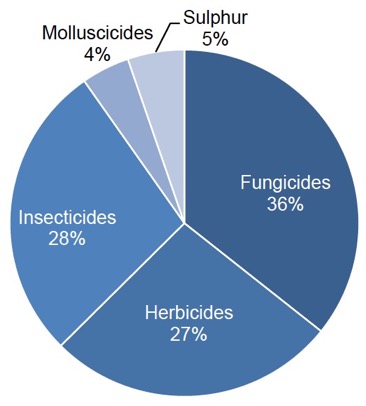
Figure 16 Timing of pesticide applications on calabrese – 2017
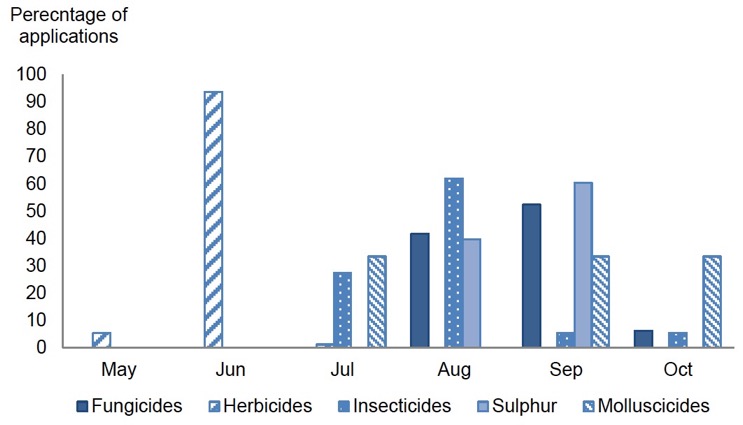
Other brassica crops
- Other brassica crops encountered in the 2017 survey were sprouting broccoli, Brussels sprouts, cauliflower and kale (in previous reports Brussels sprouts were reported separately but this was not possible in 2017 due to reduced area of crop encountered in the sample)
- The total estimated area of other brassica crops was 1,796 hectares
- 99 per cent of other brassica crops were grown from transplants
- 97 per cent of the other brassica crop was treated with a pesticide (see Figure 17 for types of pesticides used)
- Pesticide formulations were applied to 39,650 treated hectares with 9,266 kilograms of pesticide applied in total (see summary table below)
- The 97 per cent of other brassica crops treated with a pesticide received on average 12.6 pesticide applications (Table 1). These included 6.3 molluscicide, 5.7 fungicide, 4.3 insecticide and 2.6 herbicide applications (applied to 76, 88, 97 & 88 per cent of the crop respectively)
- The timings of pesticide applications are shown in Figure 18
- General disease control and general pest control were the only specified reasons reported for fungicide and insecticide application respectively (84 and 83 per cent of use respectively). Reasons for herbicide applications were supplied for 79 per cent of total use. Thirty nine per cent for annual broad-leaf weeds, 26 per cent for annual meadow grass and 13 per cent for general weed control
Summary of pesticide use on other brassicas:
| Pesticide group |
Formulation area treated |
Weight of pesticides applied |
Percentage of crop treated |
Most used formulations |
|---|---|---|---|---|
| ha |
kg |
% |
ha |
|
| Fungicides |
11,656 |
3,686 |
88 |
Prothioconazole (2,757) |
| Herbicides |
5,310 |
3,375 |
88 |
Metazachlor (1,822) |
| Insecticides |
13,839 |
775 |
97 |
Lambda-cyhalothrin (3,850) |
| Molluscicides |
8,654 |
1,280 |
76 |
Ferric phosphate (4,837) |
| Sulphur |
185 |
148 |
5 |
N/A |
| Seed treatments |
6 |
<0.5 |
<0.5 |
Iprodione, Metalaxyl-M, Thiram (all 2) |
| All pesticides |
39,650 |
9,266 |
97 |
N/A = not applicable
Figure 17 Use of pesticides on other brassica crops (percentage of total area treated with formulations) – 2017
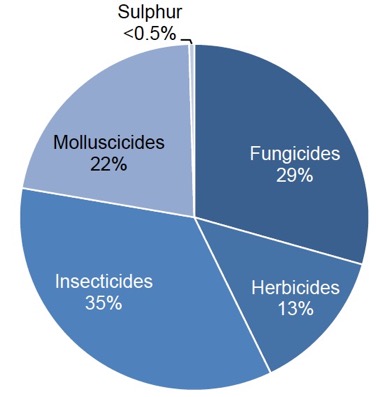
Figure 18 Timing of pesticide applications on other brassica crops – 2017
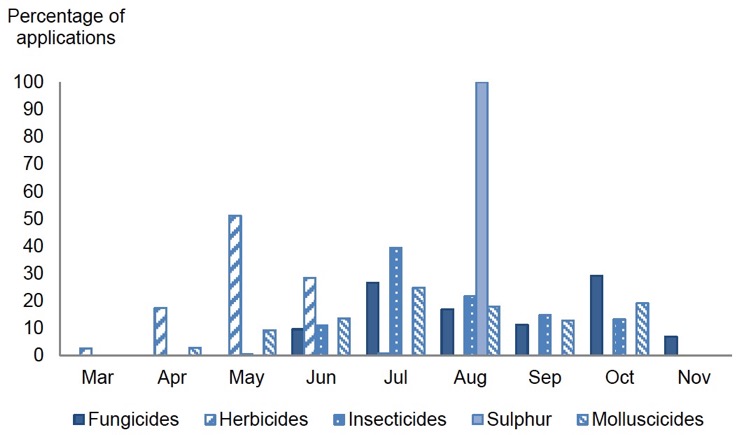
Carrots
- An estimated 3,785 hectares of carrots was grown in Scotland in 2017, an increase of 30 per cent since 2015. This consists of 3,752 hectares recorded in the ‘carrots’ census category and 32 hectares in the ‘other vegetable’ category
- 76 per cent of the crop was treated with a pesticide (see Figure 19 for types of pesticides used)
- Pesticide formulations were applied to 51,781 treated hectares with 19,381 kilograms of pesticide applied in total (see summary table below)
- The 76 per cent of carrot crop treated with a pesticide received on average 10.1 applications ( Table 1). These included 6.4 fungicide applications, 3.6 insecticide applications and 3.1 herbicide applications (applied to 76 percent of the crop)
- The timing of pesticide applications is shown in Figure 20
- Reasons for fungicide applications were supplied for 27 per cent of total use; 11 per cent for Sclerotinia, eight per cent for disease control/prevention, four per cent for both cavity spot and crown rot and less than one per cent for Alternaria. Reasons for insecticide/ nematicide applications were supplied for 40 per cent of total use; 27 per cent for carrot fly, nine per cent for aphids and three per cent for nematodes
- 56 per cent of herbicide use was for general weed control; 10 per cent for fumitory, eight per cent for annual broad-leaved weeds, six per cent for annual meadow grass and annual grass weeds, five per cent for mayweed and control of volunteers with others accounting for the final four per cent (others included groundsel, bindweed and fools parsley)
- The most common variety encountered was Nairobi, accounting for 71 per cent of the sample area surveyed
Summary of pesticide use on carrots:
| Pesticide group |
Formulation area treated |
Weight of pesticides applied |
Percentage of crop treated |
Most used formulations |
|---|---|---|---|---|
| ha |
kg |
% |
ha |
|
| Fungicides |
18,731 |
6,625 |
76 |
Isopyrazam (4,109) |
| Herbicides |
18,237 |
8,684 |
76 |
Linuron (5,966) |
| Insecticides |
10,349 |
1,841 |
76 |
Lambda-cyhalothrin (7,417) |
| Seed treatments |
4,149 |
113 |
63 |
Cymoxanil/fludioxonil/ metalaxyl-M (2,394) |
| Physical control |
314 |
2,117 |
8 |
Garlic (314) |
| All pesticides |
51,781 |
19,381 |
76 |
Figure 19 Use of pesticides on carrots (percentage of total area treated with formulations) – 2017
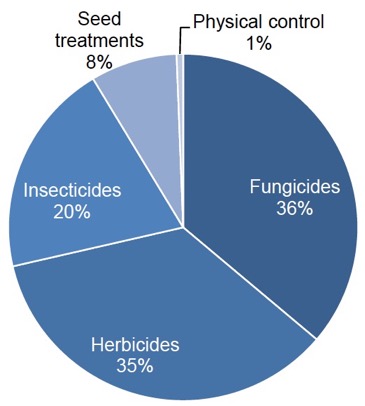
Figure 20 Timing of pesticide applications on carrots – 2017
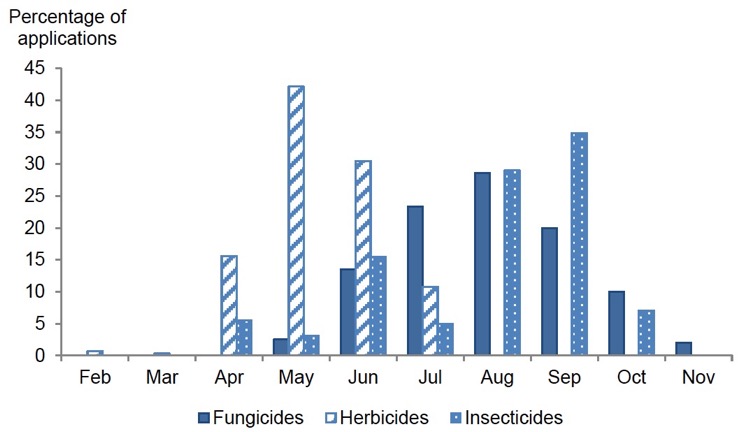
Note: Physical control was all applied in April
Turnips and swedes
- The total estimated area of turnips and swedes grown in 2017 was 1,434 hectares, representing a five per cent decrease from 2015. 1,413 hectares were recorded in the ‘turnips & swedes’ census category and 21 hectares were recorded in the ‘other vegetable’ census category
- 99 per cent of the turnip and swede crop was treated with a pesticide (see Figure 21 for types of pesticides used)
- Pesticide formulations were applied to 12,694 treated hectares with 2,481 kilograms of pesticide applied in total (see summary table below)
- The turnip and swede crop received on average 4.1 pesticide applications ( Table 1). These included two herbicide and insecticide applications (applied to 99 and 83 per cent of the crop area respectively) as well as 1.7 fungicide applications and 1.3 molluscicide applications (applied 85 and 36 per cent of the crop respectively)
- The timing of pesticide applications is shown in Figure 22
- General disease control and general pests were the only specified reasons for the use of fungicides and insecticides (88 and 99 per cent of use respectively). Reasons for herbicide applications were supplied for 97 per cent of total use; 69 per cent for general weed control, 14 per cent for annual broad-leaved weeds and 13 per cent for annual meadow grass
- The most common variety encountered was Magres, accounting for 73 per cent of the sample area surveyed
Summary of pesticide use on turnips and swedes:
| Pesticide group |
Formulation area treated |
Weight of pesticides applied |
Percentage of crop treated |
Most used formulations |
|---|---|---|---|---|
| ha |
kg |
% |
ha |
|
| Fungicides |
3,060 |
752 |
85 |
Azoxystrobin (1,547) |
| Herbicides |
3,954 |
1,477 |
99 |
Clomazone (1,403) |
| Insecticides |
3,141 |
98 |
83 |
Deltamethrin (1,261), Lambda-cyhalothrin (1,016) |
| Molluscicides |
838 |
143 |
36 |
Metaldehyde (679) |
| Seed treatments |
1,701 |
12 |
96 |
Thiram (1,340) |
| All pesticides |
12,694 |
2,481 |
99 |
Figure 21 Use of pesticides on turnips and swedes (percentage of total area treated with formulations) – 2017
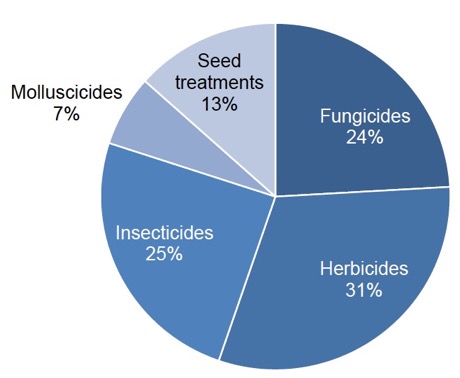
Figure 22 Timing of pesticide applications on turnips and swedes – 2017
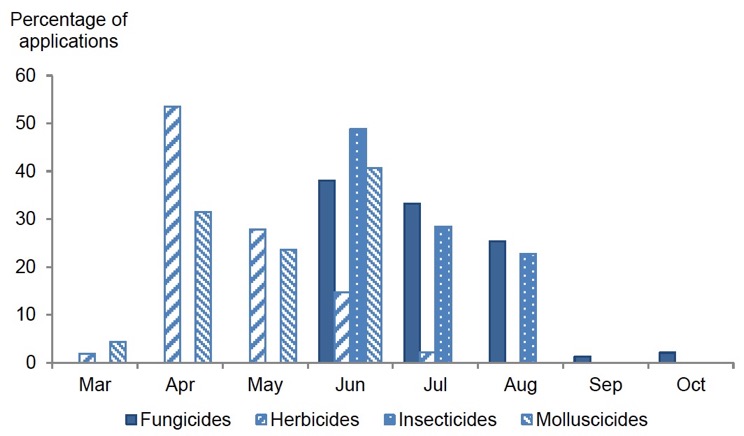
Other vegetable crops
- Other vegetable crops encountered in the 2017 survey were beetroot, leeks, lettuce, parsnips, podded peas, pumpkin, rhubarb, sweetcorn and squash
- The total estimated area of other vegetable crops was 451 hectares. This includes 23 hectares of multi-cropping
- 43 per cent of other vegetable crops were grown from transplants
- 60 per cent of other vegetable crops were treated with a pesticide (see Figure 23 for types of pesticides used)
- Pesticide formulations were applied to 2,665 treated hectares with 1,146 kilograms of pesticide applied in total (see summary table below)
- The 60 per cent of the other vegetable crop treated with a pesticide received on average 5.9 pesticide applications ( Table 1). These included 3.2 fungicide applications (applied to 57 per cent of the crop area), 2.9 insecticides, 2.4 herbicides and one molluscicide application (applied to 37, 60 & 16 per cent respectively)
- The timing of pesticide applications is shown in Figure 24
- Reasons for herbicide applications were supplied for 45 per cent of total use; 16 per cent for general weed control and 14 per cent for both annual broad-leaved weeds and annual meadow grass. General disease control and general pests were the only specified reasons for fungicide and insecticide use (61 and 56 per cent of use respectively)
Summary of pesticide use on other vegetable crops:
| Pesticide group |
Formulation area treated |
Weight of pesticides applied |
Percentage of crop treated |
Most used formulations |
|---|---|---|---|---|
| ha |
kg |
% |
ha |
|
| Fungicides |
1,064 |
519 |
57 |
Prothioconazole (205) |
| Herbicides |
914 |
615 |
60 |
Metamitron (167) |
| Insecticides |
494 |
4 |
37 |
Deltamethrin (262) |
| Molluscicides |
74 |
8 |
16 |
Metaldehyde (74) |
| Seed treatments |
120 |
1 |
22 |
Thiram (117) |
| All pesticides |
2,665 |
1,146 |
60 |
Figure 23 Use of pesticides on other vegetable crops (percentage of total area treated with formulations) – 2017
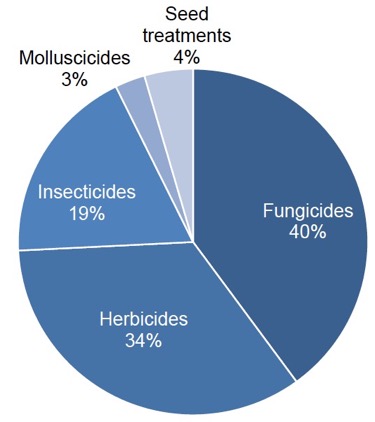
Figure 24 Timing of pesticide applications on other vegetable crops – 2017
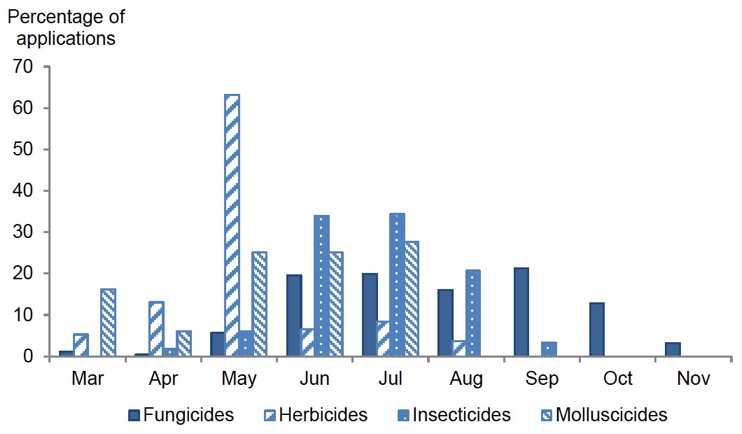
Contact
There is a problem
Thanks for your feedback